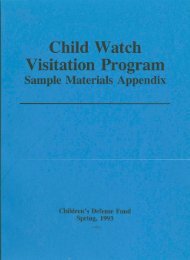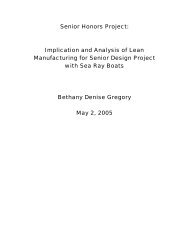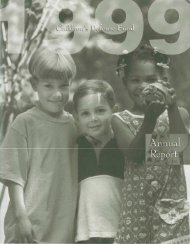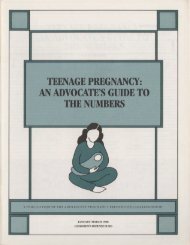children out of school in america - University of Tennessee Digital ...
children out of school in america - University of Tennessee Digital ...
children out of school in america - University of Tennessee Digital ...
You also want an ePaper? Increase the reach of your titles
YUMPU automatically turns print PDFs into web optimized ePapers that Google loves.
as opposed to every second, third, or fourth, was<br />
based on the total number <strong>of</strong> households <strong>in</strong> the area<br />
selected. Sampl<strong>in</strong>g was done consistently with<strong>in</strong><br />
Census tracts and political subdivisions, but differently<br />
among them. Households where there was<br />
no answer or 'a refusal to answer were noted and<br />
tabulated. When a monitor found no one home at<br />
the designated household, the monitor visited the<br />
preced<strong>in</strong>g household <strong>in</strong> the count. (In a few areas,<br />
the next household was visited.) The count always<br />
resumed from the orig<strong>in</strong>al household whether or not<br />
an <strong>in</strong>terview was obta<strong>in</strong>ed at the preced<strong>in</strong>g (or next)<br />
household. If there was no answer at the designated<br />
household and the household preced<strong>in</strong>g it, the monitor<br />
noted this and cont<strong>in</strong>ued on with the orig<strong>in</strong>al<br />
count from the designated household. Monitors did<br />
not go back (or forward) more than one household<br />
before the designated household.<br />
All <strong>in</strong>terview<strong>in</strong>g was done between July 1973 and<br />
March 1974. In analyz<strong>in</strong>g the data we collected, the<br />
<strong>school</strong> year 1972-1973 (both semesters) always was<br />
exam<strong>in</strong>ed. However, <strong>in</strong> some places <strong>in</strong>terview<strong>in</strong>g<br />
was done a month or more after the 1973-1974<br />
<strong>school</strong> year had begun. In those places, the analysis<br />
covered up to a three semester time period. We<br />
calculated <strong>children</strong> <strong>out</strong> <strong>of</strong> <strong>school</strong> by IWO different<br />
measures: I) <strong>children</strong> who missed three or more<br />
consecutive months <strong>of</strong> <strong>school</strong>, and 2) <strong>children</strong> who<br />
missed 45 days <strong>of</strong> <strong>school</strong>, whether or not it was<br />
consecutive. The survey analysis period for these<br />
two measures <strong>in</strong>cluded 1972-73 and that portion <strong>of</strong><br />
the first semester that had passed. Our calculations<br />
on suspension were done on this same two- and<br />
sometimes three-semester basis.<br />
Below is a brief description <strong>of</strong> each specific place<br />
we monitored.<br />
ALABAMA<br />
1. Autauga County-Beat 10<br />
While parts <strong>of</strong> Autauga County are develop<strong>in</strong>g<br />
<strong>in</strong>to a "bedroom community" suburb <strong>of</strong> Montgomery,<br />
other parts are sparsely populated and<br />
isolated. APSC staff selected such a rural portion <strong>of</strong><br />
Autauga County, political Beat 10, to survey. Beat<br />
10 consists <strong>of</strong> t<strong>in</strong>y communities, some all white and<br />
others all black, plus <strong>in</strong>dividual black and white<br />
families scattered randomly through<strong>out</strong> hills and<br />
hollows. Just as randomly situated are well-to-do<br />
and poor families. APSC staff members monitored<br />
every household dur<strong>in</strong>g the three-week period follow<strong>in</strong>g<br />
July 23, 1973.<br />
2. Montgomery<br />
a. Census Tract 3<br />
In Montgomery we wanted to survey a Census<br />
tract with low-<strong>in</strong>come families, both black and white.<br />
Census Tract 3, accord<strong>in</strong>g to 1970 Census data, is<br />
65 percent black, has a high percentage (39 percent)<br />
<strong>of</strong> families below the poverty level, and conta<strong>in</strong>s<br />
over 1,000 persons under 18. Most black families<br />
<strong>in</strong> Census Tract 3 live <strong>in</strong> New Town, the most<br />
delapidated neighborhood <strong>in</strong> Montgomery, with open<br />
ditches, abandoned cars, and condemned and<br />
burned-<strong>out</strong> houses l<strong>in</strong><strong>in</strong>g its streets. Most white families<br />
live <strong>in</strong> Chisholm, a "blue collar" enclave north<br />
<strong>of</strong> New Town. Some streets house retired couples<br />
next to poor, young families, and others house upwardly<br />
mobile and middle-<strong>in</strong>come families. Construction<br />
<strong>of</strong> an <strong>in</strong>terstate highway through the area<br />
has resulted <strong>in</strong> the abandonment <strong>of</strong> many shanties<br />
s<strong>in</strong>ce 1970. Monitor<strong>in</strong>g was done by the APSC<br />
staff from the middle to the end <strong>of</strong> January 1974.<br />
Every second household was <strong>in</strong>terviewed.<br />
b. Northgate Hous<strong>in</strong>g Project<br />
Many black families who have left New Town <strong>in</strong><br />
Census Tract 3, especially s<strong>in</strong>ce 1970, have moved<br />
<strong>in</strong>to the federally subsidized Northgate Hous<strong>in</strong>g<br />
Project <strong>in</strong> adjacent Census Tract 4. All <strong>of</strong> its residents<br />
<strong>in</strong> 100 units are black. Though constructed<br />
less than five years ago, the exteriors <strong>of</strong> its twostory<br />
units are run-down, there is no landscap<strong>in</strong>g,<br />
virtually no grass, and no playground equipment.<br />
Here aga<strong>in</strong>, monitor<strong>in</strong>g was handled by the APSC<br />
staff dur<strong>in</strong>g the latter part <strong>of</strong> January 1974. Every<br />
second household was <strong>in</strong>cluded <strong>in</strong> the survey.<br />
COLORADO<br />
Denver<br />
a. Census Tract 1.01<br />
CDF wanted to survey white <strong>children</strong> liv<strong>in</strong>g <strong>in</strong> a<br />
"blue collar" lower middle <strong>in</strong>come area <strong>in</strong> a large<br />
western city. Census Tract 1.01 <strong>in</strong> north central<br />
Denver is such an area. The 1970 Census shows<br />
Census Tract 1.01 to be one-tenth <strong>of</strong> a percent<br />
black, with fewer than 400 "persons <strong>of</strong> Spanish<br />
language" (Mexican-Americans are presently beg<strong>in</strong>-<br />
157














